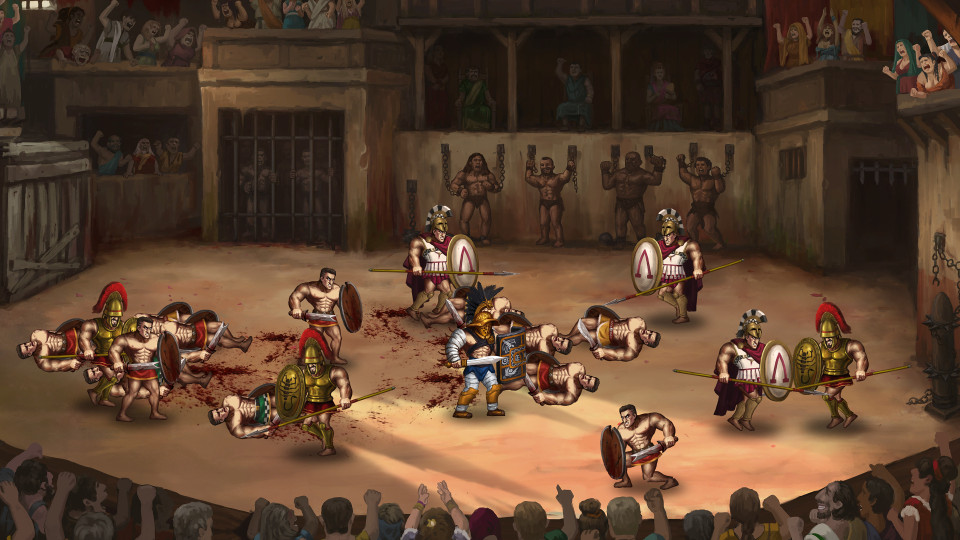Released toward the end of last year, Story of a Gladiator is an arena-based 2D brawler set in Ancient Rome. The player takes on the role of a gladiator, one who must survive against a seemingly never-ending horde of foes in a carnival of cruelty; heads are lopped off with the thwack of a particularly potent chopper, whilst tigers chow down on the massacred remains of a would-be gladiator. It’s a fantastically fun game with an intensely addictive ‘just one more go’ sensibility, but is this violent recreation of Rome’s favourite entertainment a historically realistic portrayal?

In Story of a Gladiator, the player faces an army of varied opponents in each bout. In one arena you might find yourself facing down a slathering lion, a handful of dual wielding Dimachaerus, and a plethora of Greek Hoplite impersonating Hoplomachus. The accurate representation of historical Gladiator types in Story of a Gladiator is superb, but this clearly isn’t a fair fight. Then again, if it were fair there wouldn’t be anywhere near the same challenge to the game, nor would there be the sweet sense of euphoric satisfaction when you finally overcome a particularly challenging level.
This isn’t something you’d be likely to see in the real arena, where the event organiser would put different types of gladiators up against each other with the intention of it being an interesting bout for the audience. This wasn’t a wild free-for-all, there were clear rules enforced by officials to ensure fair play.
Ancient Roman artwork suggests there were two referees who enforced strict rules on the competitors. This was no orgy of destruction, instead think of it more as an MMA bout. Violent, sure, but also conducted with an attempt at fair play.
Professor Klaus Grosschmidt of Vienna University, talking to The Guardian, suggests the most similar modern comparison is boxing:
“There were many fights and it was well organised, with a number of short fights one after another, although the crucial difference is that the gladiators were fighting for their lives, making the essence of the fighting very different.”
Evidence of this was discovered during a study of the bones of sixty-seven gladiators found in Turkey – just in case you were concerned; I’m referring to the country and not a giant man-eating rurkey here. Dr Fabian Kanz, from the Austrian Archaeological Institute, reported to New Scientist Magazine in 2006 that “Injuries to the front of each skull suggested that each opponent used just one type of weapon per bout of face-to-face contact. The lack of multiple injuries and mutilation shows that the very strict nature of combat rules for gladiator fights was adhered to.”
It’s not that there wasn’t death in the arena, just that there was an attempt to make the violence more ‘civilised’. Dr Grosscmidt and Dr Kanz also detailed how, despite most Gladiators wearing helmets, ten remains were found with square hammer-shaped injuries to the skull. They believed that this was evidence that supported the theory of there being a back-stage executioner whose role would be to humanely dispose of any gladiators too badly injured to recover.

But how likely was it for a gladiator to forfeit their lives if they were on the losing side? In Story of a Gladiator, being an action brawler, the body count soon racks up. Honestly, the pile of bodies left in the player’s wake would make even Russell Crowe feel inadequate. In one particularly memorable battle, my armoured avatar was quite literally wading through a sea of decapitated craniums whilst in pursuit of his next victim. Yet the real-world Gladiator would be unlikely to dish out or even see as much violent death in their arena.
In actual fact, most gladiators received the finest healthcare available in all of Ancient Rome. There was a simple reason for this compassion and care: money. Most, but not all Gladiators, were slaves, and the cost of training and maintaining a gladiator was quite significant. On average it took around three years to train a gladiator, so the last thing their owner (called a Lanista) would want is for their thoroughbred warrior to be dispatched on their first outing. How in Jupiter’s left elbow would they recoup their investment and make a profit if that were the case?
This excellent treatment wasn’t just down to the Lanista, it was in the arena’s best interests to protect and lengthen the life expectancy of a gladiator too. Turning to Dr Grosschmidt again, “The medical attention they received was second to none. The most famous doctor of the times, Galenus, treated gladiators at Ephesus (an ancient city in modern day Turkey).”
Professor Kathleen Coleman, writing for BBC History, explains more. “For a gladiator who died in combat,” she said, “the trainer (lanista) might charge the sponsor of the fatal spectacle up to a hundred times the cost of a gladiator who survived. Hence it was very much more costly for sponsors to supply the bloodshed that audiences often demanded, although if they did allow a gladiator to be slain it was seen as an indication of their generosity.”
The death of a gladiator was certainly not the norm, then. Instead it was a special and rare moment to send the crowd home happy, something to tell all their friends about over olives the next day. Were a venue to kill off too many of their performers on a regular basis, they would soon be out of business.

With that in mind, just how long was a Gladiator expected to survive? Some experts have calculated, based on researching headstones, that the average life expectancy was around 27 years. Several gladiators even made it to ‘old’ age. Valerie Hope writing in ‘Fighting for identity: The funerary commemoration of Italian gladiators’ detailed three individuals who made it to 38, 45, and 48 years old respectively. Whilst Alison Futrell in ‘A Sourcebook on the Roman Games’ tells of how one skilled – and probably very lucky – gladiator managed to survive an impressive 150 bouts and another who made it to the ripe old age of 90 years old before carking it. One can only imagine that he’d long since retired and wasn’t a scutum wielding OAP!
So, the real world gladiator arena wouldn’t be nearly as violent as the one Story of a Gladiator depicts, but when a video game is this entertaining, who am I to complain?





